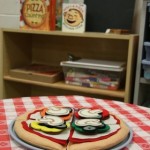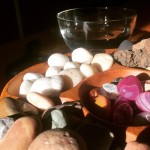
Our experiences contribute to our literacy lives in a big way. Every little activity that we participate in is filed away in our brains until there comes a time when we need it. Early childhood is such a fun and magical time to help kids see HOW these little experiences connect to their literacy lives.
Here’s an example of a nature table we set up in my kindergarten classroom. I say WE, because this was a collection made by my students and their families. They were so excited to collect tree rounds, pinecones, pussywillow cuttings, and branches to explore. We read many books about trees and kids had so many connections.

Keeping a Nature Journal is a great way for kids to document their learning. In our nature journal, we printed pictures we took, printed from websites, wrote about whole-class observations, and added a few artifacts like leaves and mini pinecones. 
In addition to our whole-class nature journal, kids had their own science journals. We learned to look at objects like scientists, draw exactly what we saw, and then use our pictures and words to document our thinking and learning.
If you’d like to know more about the inquiry process we used in our tree unit, you can find an e-book I wrote in my Teachers Pay Teachers store.
Cooking is one of my favorite things to do with young kids. I cook all the time in my kindergarten classroom. We bake cookies, make lemonade, prepare pizza, and write about our experiences. I wrote a VERY short packet, which is also available in my Teachers Pay Teachers store, about cooking in kindergarten. Usually, when we cook or prepare any sort of food item, I will also set this up as a dramatic play experience for kids as well. Story telling in dramatic play is a great way for kids to use language and retell a sequence of events as it relates to their recipe.
I love using blocks in the classroom. In early kindergarten I will put out some paper with the blocks and invite kids to label their creations. Spelling doesn’t have to be perfect. I just ask kids to say the word slowly and write down the sounds they hear. Later on, as kids become more independent with their writing, they may start writing sentences or even books about their creations. I’ve recently added wooden peg people to our block area and the kids are enjoying having characters.

Water, bubbles, and rocks are probably some of my favorite things to explore with little learners. There are SO many books out there on these topics and I find that these are high interest areas. I have collected many (maybe too many) books on these topics, but I also supplement with books from the public library. A quick search on these topics in the kids section of your online library system will give you plenty to work with.
Learning happens so frequently during our days that sometimes I think we don’t even realizing that learning is occurring for our young children. Think about the activities you do with your kids and how you might relate these to their literacy lives. Could they write a story, add a note card, or is there a book that relates. All of these experiences have learning embedded into them, but we can always extend the literacy learning!
Happy learning, Friends!




